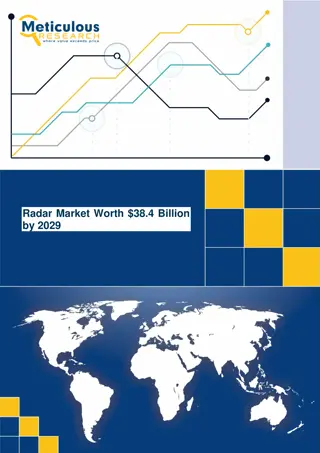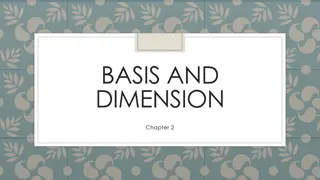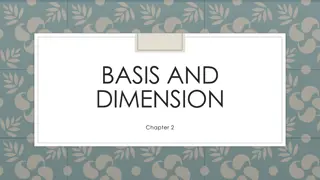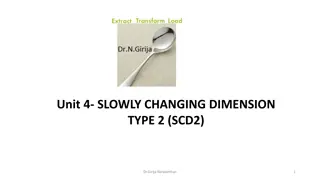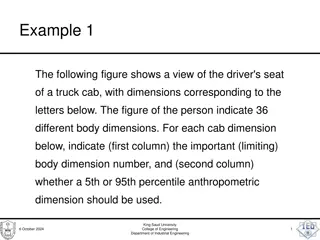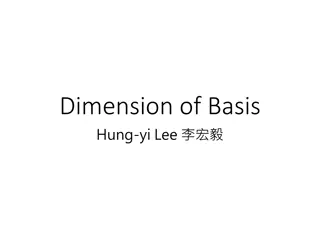
Dimensionality Reduction Techniques and Applications
Explore the concept of dimensionality reduction, its importance in handling high-dimensional data, and key techniques such as Principal Component Analysis (PCA) and Singular Vector Decomposition (SVD). Learn how reducing dimensions can alleviate the curse of dimensionality, eliminate noise, and enhance data visualization.
Uploaded on | 0 Views
Download Presentation

Please find below an Image/Link to download the presentation.
The content on the website is provided AS IS for your information and personal use only. It may not be sold, licensed, or shared on other websites without obtaining consent from the author. If you encounter any issues during the download, it is possible that the publisher has removed the file from their server.
You are allowed to download the files provided on this website for personal or commercial use, subject to the condition that they are used lawfully. All files are the property of their respective owners.
The content on the website is provided AS IS for your information and personal use only. It may not be sold, licensed, or shared on other websites without obtaining consent from the author.
E N D
Presentation Transcript
CAP5778 CAP5778 Advanced Data Mining Advanced Data Mining Dimensionality Reduction Dimensionality Reduction Peixiang Zhao Florida State university Part of the course materials are adapted or revised from Mining of Massive Datasets (mmds.org)
High Dimensional Data High Dimensional Data High dim. data Graph data Infinite data Machine learning Apps Locality sensitive hashing Filtering data streams PageRank, SimRank Recommen der systems SVM Network Analysis Web Decision Trees Association Rules Clustering advertising Dimensional ity reduction Duplicate document detection Spam Detection Queries on streams Perceptron, kNN 1
Introduction Introduction Curse of dimensionality When dimensionality increases, data becomes increasingly sparse Density and distance between points becomes less meaningful The possible combinations of subspaces will grow exponentially Dimensionality reduction Avoid the curse of dimensionality Help eliminate irrelevant features and reduce noise Reduce time and space costs in data mining Allow easier visualization Dimensionality reduction techniques Principal Component Analysis (PCA) Singular Vector Decomposition (SVD) 2
Dimensionality Reduction Dimensionality Reduction Assumptions Data lies on or near a low d-dimensional subspace Axes of this subspace are effective representation of the data 3
Rank of A Matrix Rank of A Matrix What is rank of a matrix A? Number of linearly independent columns of A Example Matrix A = Rank r = 2 What do we care about low rank? New coordinates to represent the original data We can write A A as two basis vectors: [1 2 1] [-2 -3 1] 4
Rank is Dimensionality Rank is Dimensionality Cloud of points 3D space: Think of point positions as a matrix: A A B C One row per point: We can rewrite coordinates more efficiently! Old basis vectors: [1 0 0] [0 1 0] [0 0 1] New basis vectors: [1 2 1] [-2 -3 1] Then A has new coordinates: [1 0]. B: [0 1], C: [1 1] Notice: We reduced the number of coordinates 5
Principle Component Analysis Principle Component Analysis Goal: To find a projection of data that captures the largest amount of variation in data The original data are projected onto a much smaller space, resulting in dimensionality reduction The direction with the largest projected variance is called the first principal component The orthogonal direction that captures the second largest projected variance is called the second principal component and so on The direction that maximizes the variance is also the one that minimizes the mean squared error 6
A Motivating Example A Motivating Example A dataset resulting from a survey of pilots for radio-controlled helicopters x1is a measure of the piloting skill of a pilot x2captures how much he/she enjoys flying The two attributes x1and x2are strongly correlated! The data actually lie along some diagonal axis (u1) Question: how can we automatically compute u1? 7
Problem Formulation Problem Formulation Reduce data from d-dimension to k-dimension (k << d) Find k vectors u1, u2, ,ukonto which to project data so as to maximize the variance of the projected data minimize the projection error (squared projection distance) 8
PCA: General Procedure PCA: General Procedure Given n data vectors from d-dimensions, find k d orthogonal vectors (principal components) that can represent data 1. Normalize input data: Each attribute falls within the same range 2. Compute k orthonormal (unit) vectors, i.e., principal components 3. Each input data (vector) is a linear combination of the k principal component vectors 4. The principal components are sorted in order of decreasing significance or strength 5. Since the components are sorted, the size of the data can be reduced by eliminating the weak components, i.e., those with low variance (using the strongest k principal components, it is possible to reconstruct a good approximation of the original data) 9
PCA: Input PCA: Input Input: an n*d data matrix D Rows: also called instances, examples, records, transactions, objects, points, feature-vectors, etc. Given as a d-tuple xi= (xi1, xi2, . . . , xid) Columns: also called attributes, properties, features, dimensions, variables, fields, etc. Given as an n-tuple xj= (x1j, x2j, . . . , xnj) 10
An Example An Example 11
PCA: Algorithm PCA: Algorithm Preprocessing the data to normalize its mean and variance 1. The mean of the data matrix D is the average of all the points 2. Replace each xi with xi to get the centered data matrix Z Steps 1-2 zero out the mean of the data 12
PCA: Algorithm PCA: Algorithm Preprocessing the data to normalize its mean and variance (optional) 1 ? ?(???)2,1 ? ? 2= 3. Let ?? ??? ?? 4. Replace each ???with Steps (3-4) rescale each coordinate to have unit variance, which ensures that different attributes are all treated on the same scale May be omitted if we had a priori knowledge that the different attributes are all on the same scale 13
PCA: Algorithm PCA: Algorithm Reduce data from d-dimensions to k-dimensions Compute the covariance matrix (d*d) 1 ???? = ??,?(diagonal) is the variance of variable i ??,?(off-diagonal) is the covariance between variables i and j Compute eigenvectors of the matrix [U U, S S, V] = svd svd( ) U U: d*d matrix with eigenvectors S S: d*d diagonal matrix with eigenvalues: 1 1, , 2 2, , Select the first k columns of U as principal components: Ureduce(d*k) For ? ??, the new representation in the k-dimensional space (Ureduce)T* x ( k*1 vector) , , d d 14
How to Choose the Dimensionality How to Choose the Dimensionality One criteria for choosing k is to compute the fraction of the total variance captured by the first k principal components Given a certain desired variance threshold, say , starting from the first principal component, we keep on adding additional components, and stop at the smallest value k, for which f (k) we select the fewest number of dimensions such that the subspace spanned by those k dimensions captures at least fraction of the total variance 15
PCA: Algorithm PCA: Algorithm 16
PCA: Example PCA: Example 17
PCA: In Theory PCA: In Theory Given a unit vector u and a point x, the length of the projection of x onto u is xTu, the distance from the origin Goal: to maximize the variance of the projections, we need choose a unit-length u, s.t. ? ? ?=? ?((??)??)?= ? ? ?=? ?? = ??(? ? ? ?????? ?)? ? ?=? ???? This gives the principal eigenvector of the covariance matrix of the data! 18
Optimal and Non Optimal and Non- -optimal 2D Approximations optimal 2D Approximations The optimal subspace maximizes the variance, and minimizes the squared error, whereas the non-optimal subspace captures less variance, and has a high mean squared error value, as seen from the lengths of the error vectors (line segments) 19
Singular Vector Decomposition Singular Vector Decomposition A[m x n]= U[m x r] r x r](V[n x r])T A: Input data matrix m x n matrix (e.g., m documents, n terms) U: Left singular vectors m x r matrix (m documents, r concepts : Singular values r x r diagonal matrix (strength (r : rank of the matrix A) V: Right singular vectors n x r matrix (n terms, r concepts) concepts) strength of each concept ) 20
SVD SVD T n n r r r V VT T m m A A U U i: singular values ui: orthonormal vector vi: orthonormal vector 21
SVD SVD - - Properties Properties It is always possible to decompose a real matrix A into A = U VT, where U, ,V: unique U, V: column orthonormal U UT TU = I U = I; V VT TV = I V = I (I I: identity matrix) (Columns are orthogonal : diagonal singular values) are positive, and sorted in decreasing order ( 1 1 2 2 ... ... 0 0) orthogonal unit unit vectors) Entries (singular values 22
SVD: Example SVD: Example A = U VT: Users to Movies Casablanca Star Wars Titanic Matrix 1 1 1 0 0 3 3 3 0 0 4 4 4 0 0 5 5 5 0 0 0 2 0 4 4 0 0 0 5 5 0 1 0 2 2 Alien n Alex Bob V VT T Chris = m Dave Eason Frank U U Gil Concepts a.k.a. Latent dimensions 23
SVD: Example SVD: Example A = U VT: Users to Movies Casablanca Star Wars Titanic Matrix 1 1 1 0 0 3 3 3 0 0 4 4 4 0 0 5 5 5 0 0 0 2 0 4 4 0 0 0 5 5 0 1 0 2 2 Alien 0.13 0.02 -0.01 0.41 0.07 -0.03 0.55 0.09 -0.04 0.68 0.11 -0.05 0.15 -0.59 0.65 0.07 -0.73 -0.67 0.07 -0.29 0.32 Alex Bob 12.4 0 0 0 9.5 0 0 0 1.3 Chris = x x Dave Eason Frank Gil 0.56 0.59 0.56 0.09 0.09 0.12 -0.02 0.12 -0.69 -0.69 0.40 -0.80 0.40 0.09 0.09 24
SVD: Example SVD: Example A = U VT: Users to Movies Casablanca U is the user-to-concept similarity matrix Star Wars Sci. Fiction Romance Titanic Matrix 1 1 1 0 0 3 3 3 0 0 4 4 4 0 0 5 5 5 0 0 0 2 0 4 4 0 0 0 5 5 0 1 0 2 2 Alien 0.13 0.02 -0.01 0.41 0.07 -0.03 0.55 0.09 -0.04 0.68 0.11 -0.05 0.15 -0.59 0.65 0.07 -0.73 -0.67 0.07 -0.29 0.32 Alex Bob 12.4 0 0 0 9.5 0 0 0 1.3 Chris = x x Dave Eason Frank Gil 0.56 0.59 0.56 0.09 0.09 0.12 -0.02 0.12 -0.69 -0.69 0.40 -0.80 0.40 0.09 0.09 25
SVD: Example SVD: Example A = U VT: Users to Movies Casablanca Strength of the concept for Sci. Fiction Star Wars Sci. Fiction Titanic Matrix 1 1 1 0 0 3 3 3 0 0 4 4 4 0 0 5 5 5 0 0 0 2 0 4 4 0 0 0 5 5 0 1 0 2 2 Alien 0.13 0.02 -0.01 0.41 0.07 -0.03 0.55 0.09 -0.04 0.68 0.11 -0.05 0.15 -0.59 0.65 0.07 -0.73 -0.67 0.07 -0.29 0.32 Alex Bob 12.4 0 0 0 9.5 0 0 0 1.3 Chris = x x Dave Eason Frank Gil 0.56 0.59 0.56 0.09 0.09 0.12 -0.02 0.12 -0.69 -0.69 0.40 -0.80 0.40 0.09 0.09 26
SVD: Example SVD: Example A = U VT: Users to Movies Casablanca V is the movie-to-concept similarity matrix Star Wars Sci. Fiction Titanic Matrix 1 1 1 0 0 3 3 3 0 0 4 4 4 0 0 5 5 5 0 0 0 2 0 4 4 0 0 0 5 5 0 1 0 2 2 Alien 0.13 0.02 -0.01 0.41 0.07 -0.03 0.55 0.09 -0.04 0.68 0.11 -0.05 0.15 -0.59 0.65 0.07 -0.73 -0.67 0.07 -0.29 0.32 Sci. Fiction Alex Bob 12.4 0 0 0 9.5 0 0 0 1.3 Chris = x x Dave Eason Frank Gil 0.56 0.59 0.56 0.09 0.09 0.12 -0.02 0.12 -0.69 -0.69 0.40 -0.80 0.40 0.09 0.09 27
Dimensionality Reduction Dimensionality Reduction Question: How exactly is the dimensionality reduction done based on SVD? Set the smallest singular values to ZERO 1 1 1 0 0 3 3 3 0 0 4 4 4 0 0 5 5 5 0 0 0 2 0 4 4 0 0 0 5 5 0 1 0 2 2 0.13 0.02 -0.01 0.41 0.07 -0.03 0.55 0.09 -0.04 0.68 0.11 -0.05 0.15 -0.59 0.65 0.07 -0.73 -0.67 0.07 -0.29 0.32 12.4 0 0 0 9.5 0 0 0 1.3 = x x 0.56 0.59 0.56 0.09 0.09 0.12 -0.02 0.12 -0.69 -0.69 0.40 -0.80 0.40 0.09 0.09 28
Dimensionality Reduction Dimensionality Reduction Question: How exactly is the dimensionality reduction done based one SVD? Set the smallest singular values to ZERO 1 1 1 0 0 3 3 3 0 0 4 4 4 0 0 5 5 5 0 0 0 2 0 4 4 0 0 0 5 5 0 1 0 2 2 0.13 0.02 0.41 0.07 0.55 0.09 0.68 0.11 0.15 -0.59 0.07 -0.73 0.07 -0.29 12.4 0 0 9.5 x x 0.56 0.59 0.56 0.09 0.09 0.12 -0.02 0.12 -0.69 -0.69 29
Dimensionality Reduction Dimensionality Reduction ?????2 Frobenius Norm: ||?||?= Goal: to find an approximation matrix B in order to minimize the ??(??? ???)2 reconstruction error: ||? ?||?= 1 1 1 0 0 3 3 3 0 0 4 4 4 0 0 5 5 5 0 0 0 2 0 4 4 0 0 0 5 5 0 1 0 2 2 0.92 0.95 0.92 0.01 0.01 2.91 3.01 2.91 -0.01 -0.01 3.90 4.04 3.90 0.01 0.01 4.82 5.00 4.82 0.03 0.03 0.70 0.53 0.70 4.11 4.11 -0.69 1.34 -0.69 4.78 4.78 0.32 0.23 0.32 2.01 2.01 30
SVD: Best Low SVD: Best Low- -rank Approximation rank Approximation Sigma U A = VT B is best approximation of A Sigma B U = VT 31
SVD: Best Low SVD: Best Low- -rank Approximation rank Approximation Theorem: Let A = U VT( 1 2 , rank(A)=r) and B = U S VT where S is a diagonal r*r matrix with si= i(i=1 k) else si=0, then B is a best rank(B)=k approximation to A What do we mean by best? B is a solution to argminB A-B Fwhere rank(B)=k ||? ?||?= ??(??? ???)2 32
SVD: Best Low SVD: Best Low- -rank Approximation rank Approximation Suppose a matrix M = PQR, that is, ???= ? ?????????? 2= ? ?(???)2= ? ?( ? ??????????)2 Consider ||?||? = ? ? ? ? ? ??????????????????? = ? ? ? ??????????????????? (???and ???= 0 unless k = l and m = n) = ? ????????????? ( ???????= 1 if k=n and 0 otherwise) = ?(???)2 Consider A B = ?( ?)??, then ||? ?||? the diagonal elements of A-B: ??? ?? The first k diagonal elements are 0 ( ???????= 1) 2equals the sum of the squares of 2 The remaining i diagonal elements are ??for k < i r To minimize ||? ?||? 2, the solution is to set si= i(i=1 k) and other si=0 ? (?? ??)2+ ?=?+1 ? ? ??2} = ??2 min??{ ?=1 ?=?+1 33
SVD vs. PCA SVD vs. PCA Consider A = U VT, and let s calculate AAT= U VT(U VT)T = U VT(V TUT) = U TUT The columns of U are orthonormal eigenvectors of AAT ATA = V TUT (U VT) = V T VT The columns of V are orthonormal eigenvectors of ATA We use DTD as the covariance matrix in PCA is a diagonal matrix containing the square roots of eigenvalues from U or V in descending order If A = ATis a symmetric matrix Its singular values are the absolute values of nonzero eigenvalues: i = | i| > 0 Its singular vectors coincide with the associated non-null eigenvectors 34
SVD: Summary SVD: Summary SVD: A= U VT: unique U: user-to-concept similarities V: movie-to-concept similarities : strength of each concept Complexity Min{O(nm2), O(n2m)} In practice it needs much less work, if we only want singular values, or the first k singular vectors, or the matrix is sparse Optimal low-rank approximation of A in terms of Frobenius norm 35
Thank you Thank you







